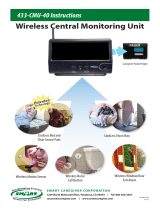Page is loading ...

WIRELESS CALL BUTTON
MODEL: F007
USER MANUAL
LED Indicator
CALL BUTTON
Push Button
Call Button
Bracket
The wireless call button works with the wireless calling &
alarm system Q034G and it allows individuals, residents,
customers, loved ones to alert caregiver/service staff for
assistance by pressing the button. It works as a nurse call
button in facilities such as clinic, medical center, care facilities,
hospital, retirement home or as a service call button in other
sectors including hospitality, education and more.
Introduction
Easy & Simple to Use
The wireless nurse call button allows individuals to signal
caregivers or service staff for assistance remotely with a
simple push on the call button
Multi-functional Call Button
The call button can be converted as a pendant and
worn around the neck with lanyard or fix it to a wall in
bed/bathroom with adhesive tapes/screws.
Smart & Portable Alert
The call button works with Q034G wireless
central monitoring unit system, pager and many more.
Caregivers can receive alert remotely anytime on the go.
Frequency: 433MHz
Operating Range: 300 ft or 100m (in open area)
Features
123
Product Specifications
*Note: surrounding metal walls or other electronic
devices might interfere or affect the signal range.
Power Supply: 12V23A battery

Side View Gently pry open with
a flathead screwdriver
to access the battery
compartment.
Front
12V 23A
+
Inside
_
Insert Batteries into Call
Buttons
Mount Call Buttons
with
Adhsive Tape
Double Adhseive
Tape
Top
Place double adhesive tape on
back of call button and mount
to wall.
Lace Lanyard Strap thru Call Button (Optional)
A
B
Top
Lace lanyard strap thru top of call
button.
Wrap loop around dark blue cord
and pull tight.
Hang call button
from the strap.
4 5 6
Instructions
Screw
Guides
Double
Adhsive
Tape
(Back of
Bracket)
A. Wall Mount with Double Adhesive Tape
The mounting brackets may be affixed
to most smooth, clean surfaces with the
included double stick tape.
B. Wall Mount with Screws (included)
The mounting bracket may be more
securely mounted to walls or headboards
with screws. Use the recessed guides for
screw placement on the bracket.
Mount Call Button to Wall with Bracket (Optional) FCC STATEMENT
This device complies with Part 15 of the FCC rules. Operation is
subject to the following two conditions:
1) this device may not cause harmful interference, and
2) this device must accept any interference received, including
interference that may cause undesired
operation.
Changes or modifications not expressly approved by the party
responsible for compliance could void your authority to operate the
equipment.
NOTE: This equipment has been tested and found to comply with the
limits for a Class B digital device, pursuant to Part 15 of the FCC
Rules. These limits are designed to provide reasonable protection
against harmful interference in a residential installation.
This equipment generates uses and can radiate radio frequency
energy and, if not installed and used in accordance with the
instructions, may cause harmful interference to radio
communications. However, there is no guarantee that interference
will not occur in a particular installation. If this equipment does
cause harmful interference to radio or television reception, which
can be determined by turning the equipment off and on, the user is
encouraged to try to correct the interference by one or more of the
following measures:
- Reorient or relocate the receiving antenna.
- Increase the separation between the equipment and receiver.
- Connect the equipment into an outlet on a circuit different from
that to which the receiver is
connected.
- Consult the dealer or an experienced radio/TV technician for help.
/




